As a parent, one of the most significant decisions you make for your child involves their education. In today’s globalized world, the array of educational pedagogies available can be both exciting and overwhelming. From the renowned Finnish education system to the holistic approach of Montessori and Waldorf, each pedagogy offers unique philosophies and methods that cater to different learning styles and developmental needs.
Understanding these educational approaches is crucial, not just in terms of academic proficiency but also in shaping your child’s overall personality, values, and worldview. The right educational environment can ignite a lifelong passion for learning, foster independence, and develop critical thinking skills. On the other hand, a mismatched educational setting might hinder your child’s natural curiosity and learning potential.
The journey to selecting an ideal educational path for your child involves more than comparing curriculums. It’s about aligning your child’s unique disposition, interests, and learning style with an environment that nurtures and challenges them in equal measure. Whether your child is a creative thinker who thrives in a student-led environment or someone who benefits from a more structured and formal educational setting, there is a pedagogy designed to meet their needs.
In this exploration, we delve into various educational systems, dissecting their core philosophies, methodologies, strengths, and limitations. Our goal is to provide you with a comprehensive understanding of each approach, from the globally acclaimed to the lesser known yet equally impactful pedagogies.
As you embark on this journey, remember that choosing an educational path for your child is not about finding a ‘one-size-fits-all’ solution. It’s about discovering a learning environment where your child can blossom both academically and personally, setting the foundation for a successful and fulfilling future.
Finnish Education System
The Finnish Education System stands as a beacon of progressive educational practices, consistently topping global education rankings. It’s an expression of a belief that less can be more when it comes to schooling.
- Qualities: The Finnish system is characterized by equal access to education, minimal emphasis on standardized testing, and a focus on student well-being. With highly qualified teachers (all possessing a master’s degree), the system leans towards fostering a love for learning rather than a drive for high test scores.
Age Group: Comprehensive education typically covers ages 7 to 16. - Class Limits: Generally, small class sizes.
- Transition: Strong emphasis on preparing students for higher education, with a focus on independent study skills.
Pros:
- Emphasizes holistic education and well-being.
- Less homework and standardized testing reduce stress on students.
- Encourages independent thinking and creativity.
- Equal educational opportunities for all children.
Cons:
- May lack the competitive edge present in other systems.
- The unique model may not be fully replicable in other cultural contexts.
- Can be perceived as too relaxed for those used to more rigorous educational systems.
Summary: The Finnish education model is ideal for parents who value a balanced approach to education, focusing not just on academic success but also on the overall well-being and happiness of the child.
International Baccalaureate (IB)
The International Baccalaureate, known for its rigorous and internationally focused curriculum, aims to develop inquisitive, knowledgeable, and caring young people.
- Qualities: IB offers a comprehensive curriculum that is respected worldwide for its academic and ethical rigor. It emphasizes inquiry-based learning, cultural awareness, and encourages students to think critically and challenge assumptions.
Age Group: Programs available from ages 3 to 19. - Class Limits: Varies, but often features small to medium-sized classes.
- Transition: Highly recognized for university admissions globally, with a strong foundation for higher studies.
Pros:
- Widely recognized by universities globally.
- Promotes a global outlook and understanding of different cultures.
- Develops strong research, writing, and analytical skills.
- Encourages a holistic approach to education with a focus on student’s personal development.
Cons:
- The curriculum can be very demanding and may not suit every student.
- The cost of IB schools can be high, limiting accessibility.
- The intensity of the program might lead to high stress among students.
Summary: The IB program is well-suited for families seeking a comprehensive and challenging education with a global perspective, preparing children for success in a rapidly changing world.
Montessori Education
Montessori Education is a child-centric approach that nurtures the natural interests and activities of the child.
- Qualities: The Montessori methodology emphasizes hands-on, self-paced, collaborative, and joyful learning. It respects individual differences and encourages children to explore and discover independently within a prepared environment. Classrooms are age-diverse, and teachers serve as guides rather than traditional instructors.
Age Group: From infancy to around age 18 (with most schools focusing on ages 3-15). - Class Limits: Mixed-age classrooms with varying sizes.
- Transition: Can require adaptation for students transitioning to traditional schools, especially at higher levels.
Pros:
- Encourages independence and self-discipline.
- Respects individual learning styles and paces.
- Develops a strong sense of community and collaboration.
- Fosters curiosity and a love for learning.
Cons:
- May lack the structure some students need for effective learning.
- Assessment of academic progress can be less formal, making transitions to conventional schools challenging.
- The effectiveness can vary significantly depending on the school and its adherence to Montessori principles.
Summary: Ideal for parents who want their children to develop at their own pace in a nurturing environment that fosters independence and a lifelong love for learning.
Waldorf (Steiner) Education
Waldorf Education emphasizes a holistic approach to learning, integrating arts, academics, and practical skills.
- Qualities: Based on the philosophy of Rudolf Steiner, Waldorf schools focus on fostering creativity, imagination, and emotional development. The curriculum is designed to align with children’s developmental stages, avoiding early use of technology and emphasizing hands-on activities and creative play.
Age Group: From preschool to high school (ages 3-18).
- Class Limits: Often smaller class sizes.
- Transition: May require adjustment for traditional higher education paths, although Waldorf diplomas are gaining recognition.
Pros:
- Encourages creativity and imaginative thinking.
- Focuses on the child’s overall development, including emotional and artistic growth.
- Creates a strong sense of community and understanding of the natural world.
- Teaches a wide range of subjects, including arts, crafts, music, and languages.
Cons:
- May not align with traditional academic expectations.
- Less emphasis on technology and conventional assessments.
- The unique approach may not transition seamlessly into more traditional educational systems.
Summary: An excellent choice for parents who prioritize creative, holistic development and want an alternative to traditional academic-focused education.
Democratic Schools
Democratic Schools prioritize student choice and empowerment in the learning process.
- Qualities: In these schools, the educational approach is centered around student democracy and self-determination. The curriculum is often flexible, allowing students to have a significant say in their learning content and methods. Decision-making processes within the school, including rules and policies, often involve student input.
- Age Group: Typically for primary and secondary education.
- Class Limits: Varies, often small and flexible.
- Transition: Students may need to adapt to more structured environments in higher education.
Pros:
- Fosters a strong sense of autonomy and independence in students.
- Encourages critical thinking, decision-making skills, and responsibility.
- Promotes democratic values and social equality.
- Creates an inclusive environment where all voices are heard and valued.
Cons:
- The non-traditional approach may not provide the structured guidance some students need.
- Assessment and progression can be less defined, making transitions to conventional educational systems challenging.
- May not focus as intensively on traditional academic subjects.
Summary: Best suited for families who value a high degree of independence and democratic participation in their child’s education, and for students who are self-motivated learners.
Krishnamurti Schools
Krishnamurti Schools are based on the educational philosophy of Jiddu Krishnamurti, focusing on holistic learning.
- Qualities: These schools emphasize the development of the whole child, including emotional and psychological aspects, alongside academic learning. The curriculum encourages self-awareness, deep understanding of oneself and the world, and fosters a spirit of inquiry and exploration.
Age Group: Primary to high school. - Class Limits: Generally small.
- Transition: Focus on holistic development may require adjustments for traditional higher education systems.
Pros:
- Focuses on holistic development, including emotional and psychological well-being.
- Encourages independent thought and in-depth understanding of subjects.
- Promotes a peaceful, cooperative learning environment.
- Prioritizes personal growth and self-discovery over competition.
Cons:
- May not align with traditional academic standards and assessments.
- The focus on self-discovery and personal growth might not suit all students.
- Transitioning to more traditional educational systems may require adjustments.
Summary: Ideal for families who prioritize deep, introspective learning and holistic development over conventional academic achievement.
Reggio Emilia Approach
The Reggio Emilia Approach is an innovative educational system primarily for early childhood education, originating from Italy.
- Qualities: This approach views young children as knowledgeable and capable of constructing their own learning. It emphasizes a project-based, collaborative approach with a focus on exploration and discovery. The learning environment, considered the ‘third teacher’, is filled with stimulating materials and opportunities for experiential learning.
- Age Group: Primarily early childhood (up to age 6).
- Class Limits: Small, with a high teacher-to-student ratio.
- Transition: Smooth transition to primary education; adaptation needed for traditional systems.
Pros:
- Encourages creativity, exploration, and self-expression.
- Views children as active participants in their learning journey.
- Promotes collaboration and communication skills.
- Tailors learning experiences to the interests and inquiries of the children.
Cons:
- May lack structured learning objectives found in traditional educational models.
- Assessment methods are less formal, which might not satisfy all parents.
- Transition to traditional primary education systems may require adjustment.
Summary: An excellent option for parents who value creativity, exploration, and a child-led approach in the early years of education.
Cambridge International (IGCSE)
Cambridge International, including IGCSE, is a globally recognized education system affiliated with Cambridge University.
- Qualities: The IGCSE offers a broad, flexible curriculum with a wide range of subject options. It is known for its academic rigor and balanced approach, preparing students for further education and life beyond school. The curriculum emphasizes critical thinking, inquiry, and application of knowledge.
- Age Group: From primary to pre-university (ages 5-19).
- Class Limits: Varies.
- Transition: IGCSE and A-Levels are highly recognized for university admissions worldwide.
Pros:
- Globally recognized qualifications, facilitating easy transitions to universities worldwide.
- Wide range of subjects allowing for personalized educational pathways.
- Focuses on developing deep understanding and application of knowledge.
- Encourages a global perspective and prepares students for international opportunities.
Cons:
- Can be academically demanding and may not suit all learning styles.
- The cost of attending Cambridge-affiliated schools can be high.
- The focus on examinations and academic achievement might be stressful for some students.
Summary: Ideal for families seeking a comprehensive, globally recognized education that offers a balance of academic rigor and application-oriented learning.
CBSE (Central Board of Secondary Education)
The Central Board of Secondary Education is a prevalent national education board in India, known for its standardized curriculum across affiliated schools.
- Qualities: CBSE’s curriculum is designed to prepare students for entrance examinations for higher education in India. It focuses heavily on Science and Mathematics, alongside a comprehensive list of other subjects. The board promotes a balanced academic and co-curricular approach.
- Age Group: Primary to senior secondary (typically ages 6 to 18).
- Class Limits: Varies, depending on the school.
- Transition: The curriculum is specifically tailored to prepare students for higher education and competitive exams in India.
Pros:
- – Uniform and standardized curriculum across the country.
- – Emphasis on preparing students for higher education and competitive exams.
- – Wide recognition across India and in several other countries.
- – Focus on core academic subjects with a blend of co-curricular activities.
Cons:
- – Can be academically rigorous and exam-oriented.
- – May not offer as much flexibility in subject choices until higher secondary.
- – The focus on rote learning and memorization can be a drawback for some students.
Summary: CBSE is ideal for families looking for a robust, well-recognized education system that prepares students for higher education, particularly in India.
State Boards in India
State Boards in India offer a regionalized education system, with each state having its own board that tailors the curriculum to local needs.
- Qualities: State Boards focus on a curriculum that includes national level subjects and emphasizes regional languages, culture, and history. They cater to the specific educational requirements of each state.
- Age Group: Primary to senior secondary (typically ages 6 to 18).
- Class Limits: Varies widely from state to state and school to school.
- Transition: Students are well-prepared for state-level higher education and entrance exams, though the curriculum may not always align with national or international higher education standards.
Pros:
- – Tailored to regional requirements, incorporating local culture and languages.
- – More accessible and widespread across respective states.
- – Offers a balanced approach to academic and co-curricular activities.
Cons:
- – Varies significantly in quality and content from state to state.
- – May not be as recognized internationally as CBSE or other national boards.
- – The focus on regional aspects might limit exposure to a broader curriculum.
Summary: State Boards are suitable for families who prioritize regional education and are looking for a system that integrates local cultural and linguistic elements.
These descriptions provide insights into the characteristics, advantages, and limitations of both the CBSE and State Boards in India, helping parents make informed decisions based on their preferences and requirements.
Choosing the Right Pedagogy for Your Child

Selecting the most suitable educational path for your child is a decision that requires thoughtful consideration of several factors. Each child is unique, with their own learning style, interests, and developmental needs. Here’s a guide to help you navigate through this important decision:
- Understand Your Child’s Learning Style and Needs: Observe how your child learns best. Do they thrive in a structured environment, or do they prefer more freedom to explore and discover? Are they more hands-on or do they excel in traditional academic settings?
- Consider Your Child’s Interests and Strengths: Align the educational approach with your child’s interests and strengths. A child passionate about arts may flourish in a Waldorf or Reggio Emilia setting, while a child showing early academic strengths might thrive in a more traditional system like the IGCSE.
- Reflect on Your Educational Values: What do you value most in your child’s education? Is it academic rigor, holistic development, creative freedom, or preparation for global opportunities? Your own educational values and expectations play a crucial role in this decision.
- Research and Visit Schools: Explore schools that offer different pedagogies. Visit them, if possible, to get a feel for the environment and teaching style. Talk to educators and parents to gain insights into the school’s approach and outcomes.
- Consider Long-Term Goals: Think about your child’s long-term educational journey. How does the chosen pedagogy align with future educational transitions, be it secondary education, university, or vocational paths?
- Be Open to Change: Remember, the chosen educational path is not set in stone. Be open to reevaluating and making changes if your child’s needs or circumstances change.
Choosing the right educational pedagogy for your child is a journey. It’s about finding a balance between your child’s individual needs, your family values, and the educational outcomes you desire. By understanding the different options and carefully considering your child’s unique profile, you can make a decision that sets the foundation for their lifelong learning and success.




